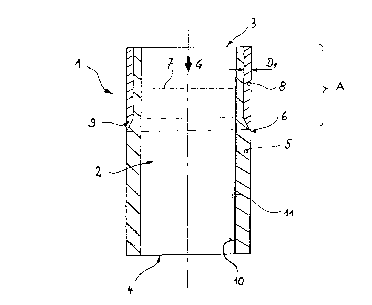Some of the information on this Web page has been provided by external sources. The Government of Canada is not responsible for the accuracy, reliability or currency of the information supplied by external sources. Users wishing to rely upon this information should consult directly with the source of the information. Content provided by external sources is not subject to official languages, privacy and accessibility requirements.
Any discrepancies in the text and image of the Claims and Abstract are due to differing posting times. Text of the Claims and Abstract are posted:
| (12) Patent: | (11) CA 2247785 |
|---|---|
| (54) English Title: | MOLDS FOR A CONTINUOUS CASTING SYSTEM |
| (54) French Title: | MOULES POUR SYSTEME DE COULEE EN CONTINU |
| Status: | Expired and beyond the Period of Reversal |
| (51) International Patent Classification (IPC): |
|
|---|---|
| (72) Inventors : |
|
| (73) Owners : |
|
| (71) Applicants : |
|
| (74) Agent: | G. RONALD BELL & ASSOCIATES |
| (74) Associate agent: | |
| (45) Issued: | 2002-11-26 |
| (22) Filed Date: | 1998-09-18 |
| (41) Open to Public Inspection: | 1999-04-25 |
| Examination requested: | 1998-11-26 |
| Availability of licence: | N/A |
| Dedicated to the Public: | N/A |
| (25) Language of filing: | English |
| Patent Cooperation Treaty (PCT): | No |
|---|
| (30) Application Priority Data: | ||||||
|---|---|---|---|---|---|---|
|
The invention concerns a mold for a continuous casting system
with a shaping mold tube made of a material with high thermal
conductivity. To reduce the rate of heat removal at the height
of the meniscus that forms within the mold cavity, the
exterior of the mold tube is provided with a plating of a
material of lower thermal conductivity than that of the mold
tube. This results in reduced heat flow with higher
temperatures in the meniscus area and in improvement in the
surface quality of the cast billet.
L'invention a trait à un moule pour un système de coulée en continu comprenant un tube de moule fait d'un matériau d'une grande conductivité thermique. Pour réduire le taux d'évacuation de chaleur à la hauteur du ménisque qui se forme à l'intérieur de la cavité du moule, l'extérieur du tube de moule est recouvert d'un matériel d'une conductivité thermique inférieure à celle du tube, ce qui permet de réduire le flux thermique lorsque les températures sont plus élevées dans la zone du ménisque et d'améliorer la qualité de la surface de la billette coulée.
Note: Claims are shown in the official language in which they were submitted.
Note: Descriptions are shown in the official language in which they were submitted.

2024-08-01:As part of the Next Generation Patents (NGP) transition, the Canadian Patents Database (CPD) now contains a more detailed Event History, which replicates the Event Log of our new back-office solution.
Please note that "Inactive:" events refers to events no longer in use in our new back-office solution.
For a clearer understanding of the status of the application/patent presented on this page, the site Disclaimer , as well as the definitions for Patent , Event History , Maintenance Fee and Payment History should be consulted.
| Description | Date |
|---|---|
| Time Limit for Reversal Expired | 2017-09-18 |
| Letter Sent | 2016-09-19 |
| Letter Sent | 2015-10-20 |
| Letter Sent | 2015-10-20 |
| Letter Sent | 2015-10-20 |
| Inactive: Multiple transfers | 2015-08-31 |
| Inactive: IPC from MCD | 2006-03-12 |
| Inactive: IPC from MCD | 2006-03-12 |
| Grant by Issuance | 2002-11-26 |
| Inactive: Cover page published | 2002-11-25 |
| Pre-grant | 2002-07-18 |
| Inactive: Final fee received | 2002-07-18 |
| Amendment After Allowance Requirements Determined Compliant | 2002-07-11 |
| Letter Sent | 2002-07-11 |
| Amendment After Allowance (AAA) Received | 2002-05-17 |
| Notice of Allowance is Issued | 2002-01-30 |
| Letter Sent | 2002-01-30 |
| Notice of Allowance is Issued | 2002-01-30 |
| Inactive: Approved for allowance (AFA) | 2002-01-21 |
| Amendment Received - Voluntary Amendment | 2001-12-20 |
| Inactive: S.30(2) Rules - Examiner requisition | 2001-06-22 |
| Inactive: Cover page published | 1999-05-21 |
| Application Published (Open to Public Inspection) | 1999-04-25 |
| Amendment Received - Voluntary Amendment | 1999-04-13 |
| Letter Sent | 1998-12-22 |
| Inactive: Single transfer | 1998-11-27 |
| All Requirements for Examination Determined Compliant | 1998-11-26 |
| Request for Examination Requirements Determined Compliant | 1998-11-26 |
| Request for Examination Received | 1998-11-26 |
| Inactive: IPC assigned | 1998-11-24 |
| Classification Modified | 1998-11-24 |
| Inactive: IPC assigned | 1998-11-24 |
| Inactive: First IPC assigned | 1998-11-24 |
| Inactive: Courtesy letter - Evidence | 1998-11-10 |
| Inactive: Filing certificate - No RFE (English) | 1998-11-06 |
| Filing Requirements Determined Compliant | 1998-11-06 |
| Application Received - Regular National | 1998-10-30 |
There is no abandonment history.
The last payment was received on 2002-09-11
Note : If the full payment has not been received on or before the date indicated, a further fee may be required which may be one of the following
Please refer to the CIPO Patent Fees web page to see all current fee amounts.
Note: Records showing the ownership history in alphabetical order.
| Current Owners on Record |
|---|
| KME GERMANY GMBH & CO. KG |
| Past Owners on Record |
|---|
| DIRK RODE |
| HECTOR VILLANUEVA |